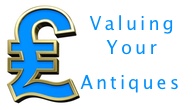
Wednesday 16th December 2015 - Della Bentham

Valuing antiques and collectibles can seem like tricky business for those with limited knowledge. Read on for our top hints and tips to help you get a valuation on your items.
Determining how much your antiques and collectibles are worth is not always an easy task. Valuing your items takes patience and potentially a great deal of research. Even then, there’s no guarantee that an item will sell for the determined value on the day. In truth, the value of any given item is determined by what a buyer is willing to pay on any given day. Having said that, some antiques and collectibles are worth more than others and, with the right information, relatively accurate valuations can be made. In this article, we offer advice on different ways to get your antiques and collectibles valued.
With a little patience and perseverance, it is possible to value your antiques and collectibles yourself.
The first thing you can try is good old trusty Google. Begin by thoroughly looking over your item. Does it have any distinguishing marks such as a maker’s stamp, date, signature or numbers? Look all around the item, both inside and out. Then type a description into google and click on the images tab to see if you can scroll through and find any similar items. Obviously, this method can be time consuming. Try changing some of the words for other descriptive words such as dark wood, walnut wood and so on to see if this produces some different results. If you find something similar, you can click on the view webpage and find out some more information about the piece. It may or may not contain a valuation, but you can use this more specific information to try another search. This method will not always pay off as you may not have enough specific information about the piece to find something similar.
For those that don’t have access to the internet or prefer to use another means of research, there are always books available. Before the days of the internet, these books were the primary means antiques dealers used to help them get an idea of the value of things they had not seen before. This method may be even more time consuming than internet searches but it can produce results.
A number of auction houses will appraise your antiques and collectibles free of charge. Whilst some may visit your home, others would prefer you to take the items along to them for valuation.
Before taking your item to be valued, call your nearest auction house and see what their policy is and make an appointment if necessary. Ensure the item is well wrapped if you are travelling with it to avoid any damage en route. As with anything, condition plays a huge part in the value of antiques and collectibles. Show them the piece in all it’s glory, by carefully cleaning or polishing it before the valuation. Remember antiques and collectibles should be specially cared for so, perhaps, take a look at a previous piece we wrote on caring for your antiques.
If you decide to sell, the auctioneer can talk you through the process and their terms and conditions.
As with auctioneers, many specialists and dealers will be happy to assist you in valuing your antiques. You can search Google, or a directory, for specialists in your local area and make a call to see if they are happy to assist you.
As above with auctioneer valuations, you should ensure your item is in it’s best condition and wrapped well for the journey. Again, if you are looking to sell your item, the dealer could point you in the right direction, or make an offer.
Located along the top tabs of our website is a handy price guide section which is a great resource for checking the amount past lots have sold for. When you click the link you will arrive on the landing page which has some commonly searched for items, such as Claris Cliff, Silver, Medals etc. If what you seek is not amongst these popular searches you can simply type a search query of your own into the search box to the left. The search function has a complete set of historical data so there is no cap on how far back the search is performed.
If you wish you can narrow down the results by hammer prices between a minimum and maximum amount of your choosing, although in most instances for valuation purposes it is probably easier to leave this unchecked so you can get the best range possible, enabling you to find items similar to your own. Try it out HERE.
The internet is a great resource, which helps save time and resources as well as connecting people all over the globe. Asking others online for help can be a really easy way top get a valuation. Simply take pictures of your item including any marks, from a few angles and write a description asking if anyone can give you any information on the item.